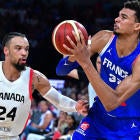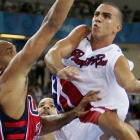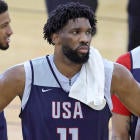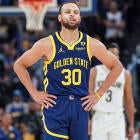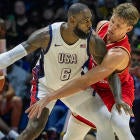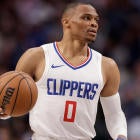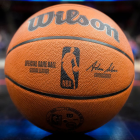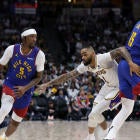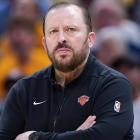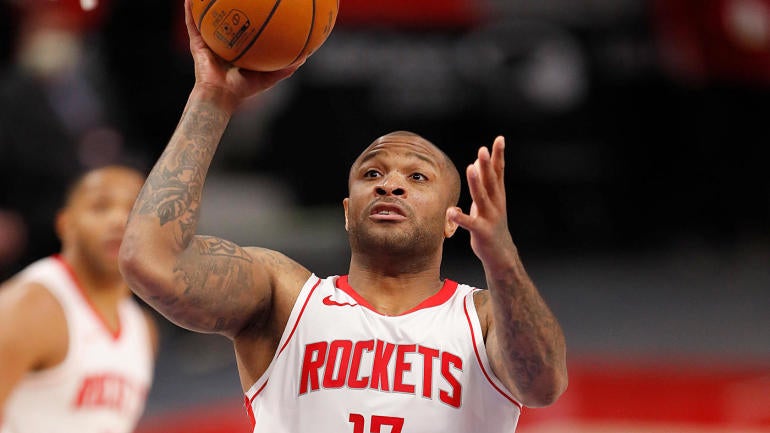
The 2020-21 regular season is barely a month old, but trade season is already (almost) upon us. The deadline isn't until March 25, but there are some key dates coming up soon:
- Tuesday, Feb. 2: Any player who is traded after this day will be ineligible to be flipped elsewhere before the deadline in another trade that aggregates his contract with another one.
- Saturday, Feb. 6: Players who signed new contracts as free agents in the offseason are eligible to be traded. (Well, most of them. The 16 players who re-signed with capped-out teams using Bird Rights or Early Bird Rights can't be traded until March 3.)
This means it's time to look at the trade market. In terms of prospective buyers, this season is unique because:
- The Celtics have a giant ($28.5 million!) trade exception from the Gordon Hayward sign-and-trade.
- The Nets have a $5.7 million disabled player exception for Spencer Dinwiddie and their $5.7 million taxpayer mid-level exception, plus Dinwiddie's $11.5 million expiring contract (with a $12.3 million player option for next season). They are all-in for obvious reasons.
- The Heat effectively created a $9.4 trade exception in the form of Meyers Leonard's contract, which has a $10.1 million player option for next season. The contracts of Avery Bradley, Andre Iguodala and Goran Dragic are all structured the same way.
- The Warriors have a $9.3 million DPE for Klay Thompson and $3.5 million left of their taxpayer MLE.
- The Nuggets have a $9.5 million exception from the Jerami Grant sign-and-trade, the Jazz have a $5 million trade exception from the Ed Davis deal, the Pacers still have their full $9.3 million MLE and the 76ers have $4.8 million of their taxpayer MLE left plus an $8.2 million exception from the Al Horford-Danny Green swap.
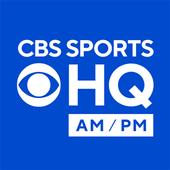
CBS Sports HQ Newsletter
Your Ultimate Guide to Every Day in Sports
We bring sports news that matters to your inbox, to help you stay informed and get a winning edge.
Thanks for signing up!
Keep an eye on your inbox.
Sorry!
There was an error processing your subscription.
We know the whole league is impatiently waiting for Bradley Beal to become available. Every year, though, there are non-blockbuster acquisitions that end up swinging playoff series -- or even, in select instances, the championship race. Think Jae Crowder (and Iguodala!) last season or Marc Gasol two years ago. Competitive teams are always trying to make meaningful upgrades. Here are eight guys they could be looking at right now (stats reflect games played before Jan. 27):
Wayne Ellington, Detroit Pistons
I could watch Ellington shoot all day. He is the rare sniper who is a threat on the move, off-balance, with a hand in his face. Before the Miami Heat discovered Duncan Robinson, Ellington was the one running around screens and launching quick-release 3s. In 2017-18, the high-water mark of his career, he shot 39.2 percent from 3-point range, but made defenses panic more than plenty of players with better percentages. The more impressive number was 10.6, his 3-point attempts per 36 minutes.
Klay Thompson has never taken more than 8.8 3s per 36 minutes in a season. Kyle Korver's career high is 9.4 per 36. This season, Ellington is shooting 10 per 36 and making a preposterous 51.9 percent of them. He has shot 14 for 24 (58.3 percent) on tightly guarded 3s, defined by NBA.com as shots taken with the closest defender 2-4 feet away. The difference between a shooter who can make uncontested 3s and a shooter who consistently makes tough ones is the difference between a player who can be neutralized in the postseason and a player who can win you a playoff game.
There is an art to Ellington's constant movement off the ball, and there is an art to his ability to get shots off against defenses actively trying to prevent him from doing so. A master of the escape dribble, Ellington has shot 14 for 21 on 3s taken after one dribble, per NBA.com. If you're guarding him, you can never relax, even if you stop the catch-and-shoot.
Ellington dealt with an Achilles injury early last season and only appeared in 36 games for the dysfunctional 2019-20 New York Knicks. He's back to his normal self with the Pistons, though, and his gravity has had a transformative effect on their offense: They've scored 115 points per 100 possessions with him on the court and 105 per 100 with him on the bench, according to Cleaning The Glass, which filters out garbage time and heaves.
If Detroit were a good team, then it would be crazy to even think about trading such a critical player on a $2.6 million contract. The Pistons are 4-14, though, and that contract is expiring at the end of this season. The 33-year-old Ellington will be eligible to be traded on Feb. 6. Any team in search of shooting should inquire.
George Hill, Oklahoma City Thunder
You had to expect some regression. Hill made 46 percent of his 3s for the Milwaukee Bucks last season, scoring 15.7 points per 36 minutes on a career-high 65.9 percent true shooting. Now that he's away from their five-out offense, on a team built around Shai Gilgeous-Alexander instead of Giannis Antetokounmpo, Hill's 3-point percentage has dipped from out-of-this-world to merely great: 38.6 percent.
But that true shooting? It's 63 percent. Hill has made a career-high 61.9 percent of his 2s in Oklahoma City. A few months from his 35th birthday, he continues to find ways to surprise.
Hill has a 19-year-old teammate, Theo Maledon, who idolized Tony Parker as a child and became Parker's protege years before he joined ASVEL, the French team Parker owns. Hill came into the league as Parker's backup, and lately he's the one who has brought Parker to mind, with an assortment of inside-the-arc tricks. Look at these floaters, reverses, and sneaky scoops:
Hill has a sprained thumb, so Maledon started in his place in the Thunder's 102-97 win in Phoenix on Wednesday and their 125-122 win in Portland on Monday. On the season, though, Oklahoma City has been 5.8 points per 100 possessions better with Hill on the court than on the bench, per CTG. Hill scored a season-high 22 points on 9-for-12 shooting against the Clippers on Sunday. Oklahoma City's starting five -- Hill, Gilgeous-Alexander, Luguentz Dort, Darius Bazley and Al Horford -- has a plus-1.4 net rating, and its bench has been the worst in the league.
If the 8-9 Thunder want to increase their lottery odds, moving Hill would help. Still a versatile defender, he is a bargain on his $9.6 million contract, and only $1.3 million of his $10 million 2021-22 salary is guaranteed. It remains sort of amazing that Milwaukee couldn't keep him out of the Jrue Holiday trade and that he didn't end up with the New Orleans Pelicans, either. The Bucks could surely still use him, and the Pelicans' roster would be much more balanced with him in Eric Bledsoe's place.
Hill has rarely been a high-usage player, and a career-high 60 percent of his made shots has been assisted in OKC, per CTG. He'd make perfect sense with the Clippers, if they're looking for a reserve guard they don't have to worry about defensively. I'd personally love to see him in Golden State if the Warriors are serious about this season, and he'd be an ideal complement to Luka Doncic in Dallas.
Nemanja Bjelica, Sacramento Kings
The Kings are starting Marvin Bagley and Richaun Holmes up front, moving Harrison Barnes to power forward with the second unit and giving the remaining center minutes to either Chimezie Metu or Hassan Whiteside, depending on the game. Bjelica hasn't played since Jan. 9, and there are conflicting reports about whether his DNP-CDs are because of a personal issue or not.
Before the extended absence, the stretch big was averaging a career-low 15.1 minutes. In this small sample, Bjelica has shot poorly, but he's a career 39 percent 3-point shooter, coming off a season in which he set a career high in true shooting percentage (60.2 percent). The Kings were 6.8 points per 100 possessions better with him on the court than off in 2018-19 and 7.2 per 100 better last season. His primary skill is spot-up shooting, but he can put it on the floor and pass on the go. He will not protect the rim like Brook Lopez, but, for a stretch big, he's not a bad defender.
With a $7.2 million expiring contract, Bjelica might be the league's safest bet to be moved before the deadline. He turns 33 in May, and the Kings have the second-worst net rating in the NBA. You might recall that Bjelica reneged on an agreement to sign a one-year, $4.5 million deal with the Philadelphia 76ers in 2018, initially saying he had decided to play in Europe and then signing a three-year, $20.5 million deal with Sacramento. Doesn't it feel like the right time for him to land up on the team he spurned? I know I'm not the only one who would like to see Ben Simmons play with a floor-spacing big when Joel Embiid is on the bench.
P.J. Tucker, Houston Rockets
Given the physical demands of his role and the heavy minutes he's played the last couple of seasons, it's a wonder that Tucker is keeping this up. He's a few months from his 36th birthday, making 44 percent of his corner 3s and switching like crazy. On Saturday he defended the 7-foot-4, 290-pound Boban Marjanovic in the post and took a charge. Tucker is 6-5.
Tucker can play at the 4 or the 5 and is still comfortable hounding star playmakers on the perimeter. He's on an $8 million expiring contract. He fits on any team interested in winning games, including these 10:
- 76ers: It is reasonable to wonder whether or not Dwight Howard and Matisse Thybulle can stay on the floor in the playoffs. There are no such concerns with Tucker, and he'd surely help in a potential matchup with Brooklyn.
- Bucks: Broadly they should be looking for anyone who is viable on both ends in a second-round series. Specifically they should be looking for someone who can step in for Brook Lopez when their drop coverage isn't working.
- Raptors: Their collective basketball IQ has dipped this season, as has their defense. Tucker would solidify their rotation and allow them to play some ridiculously switchable lineups.
- Heat: Have you heard that they like toughness? Also, they miss Crowder badly because their stretch bigs are defensive liabilities and their versatile defenders aren't stretchy.
- Jazz: As a 4, Tucker is an upgrade on Georges Niang because of his defense; as a 5, he gives them a different look than they have with Rudy Gobert or Derrick Favors. They already have awesome spacing with four deadeye shooters, so let's see them with five.
- Nuggets: Their defense has recovered a bit since their awful start, but they lost a fair bit of talent on that end in the offseason. Tucker might seem redundant for a team that has Paul Millsap and JaMychal Green, but I like the idea of playing two of them together on the second unit.
- Blazers: Tucker would help them get through this painful period without Jusuf Nurkic and Zach Collins. Their defense has been atrocious, and they desperately need to address that, even if it means the coaching staff (or front office) will have to make some difficult decisions when the team is healthier.
- Warriors: Don't you love the idea of Tucker and Draymond Green sharing the frontcourt? He'd set solid screens for Stephen Curry, and his shooting would help counter the box-and-1 and traps Curry sees on a regular basis.
- Pelicans: Zion Williamson could learn from him and benefit from improved spacing, and he'd help balance a comically unbalanced rotation. It's increasingly looking like they'll be sellers rather than buyers, though.
Thaddeus Young, Chicago Bulls
In the second quarter against the Celtics on Monday, the Bulls' Lauri Markkanen came down with a rebound. Rather than looking for a point guard, he pitched it to big man Thaddeus Young, who brought the ball up the court and executed a dribble-handoff to get Denzel Valentine an open 3.
This is notable not just because it's exactly what good early offense looks like, but because Markkanen, a grab-and-go weapon himself, chose to defer. In Chicago, it has become abundantly clear that empowering Young as a facilitator is a good idea.
Young is not the star that Domantas Sabonis has become, but he's operating in a similar way recently. He had 16 points, nine rebounds and nine assists against Boston, and he's averaging 5.4 assists per 36 minutes on the season, easily a career high. The DHOs, the short-roll passes, the dishes to cutters, it's all there:
And when he doesn't have the ball, Young is a heady cutter:
For someone whose scoring average (10.3 points per game) is exactly the same as it was last season, he is having a magnificently different experience on offense. Under Jim Boylen, he was reduced to spot-up duty, not unlike a rookie Sabonis in Oklahoma City. The twist is that the man who coached that Thunder team is the same one who has freed Young: Billy Donovan.
Comfortable, confident and much more involved, the 32-year-old Young is playing the most efficient basketball of his life. He's always had an unorthodox style and a soft touch, but now he's taking more floaters than ever and making them at a 60 percent clip, per CTG. Defenders know he wants to get to his left hand in the post, and he does it anyway.
In Charlotte last Friday, the 6-8 Young closed the game at center and the Bulls went on a 13-4 run late to earn a 123-110 victory. Donovan went with Young at the 5 to close their 125-120 win against Houston four days earlier, and he did the same when they lost by two points to the Lakers and by three points to the Clippers earlier this month. The starting lineup vs. bench numbers are getting awkward, and Young has the most extreme on/off disparity of anyone on the roster: Chicago's offense has been 9.8 points per 100 possessions better with him on the court, its defense 8.8 per 100 better.
Just like with Ellington, it is screamingly obvious that the Bulls should keep Young if they're interested in short-term winning. As things stand they rank 26th in net rating, per CTG, but their 7-10 record puts them 10th in the East. This team is more than talented enough to make the play-in tournament, especially in a conference in which the Hawks and Cavs are at .500, tied for sixth place. For Chicago to make a run at a playoff spot, it must improve defensively, and it's hard to see that happening without increasing Young's playing time.
The Bulls' front office, however, has to balance short-term goals with long-term ones. Would new team president Arturas Karnisovas turn down a first-round pick for Young? What about two seconds? He is making $13.5 million this season, and only $6 million of his $14.2 million 2021-22 salary is guaranteed. Thriving as a point-center has surely raised his value. One could hardly blame Chicago if it decides to sells high.
Derrick Rose, Detroit Pistons
The efficiency (52.2 percent true shooting) hasn't been quite where it was the last couple of years (55.5 and 55.7 percent), but Derrick Rose is still coming off the bench and producing 22.5 points and 6.9 assists per 36 minutes. The slight dip in his percentage is a result of lackluster finishing numbers, but I'm not convinced this is anything to be worried about. It's not as if he has lost his touch or his ability to get in the paint:
Rose is a tough cover. The question is what he looks like on a good team. His usage rate is 28.1 percent, which is right in between where it was last season (30.3 percent) and the season before (26.1 percent). On a per-minute basis he's shooting just as much as he did when he was a superstar in Chicago.
Shot creation becomes even more important in the playoffs, but any team adding him for that purpose needs to be prepared to hand the entire offense to him when he checks in. Rose is shooting just 6 for 19 on catch-and-shoot 3s in 285 minutes, a tiny sample, but the 19 is telling. As a point of comparison, former Pistons point guard Reggie Jackson -- also known primarily as a downhill, pick-and-roll point guard -- has played 228 minutes and is 14 for 27 on catch-and-shoot 3s. Defense is a concern, too.
Lonzo Ball, New Orleans Pelicans
On the one hand, I want to see him and Zion play together forever:
On the other, I can't say I was surprised to read that the Pelicans are open to trading him. (The Athletic's Shams Charania reported that both Ball and JJ Redick -- more on him in a minute -- are available, and ESPN's Brian Windhorst reported that they're calling teams about Bledsoe, too.)
Ball is an eccentric, divisive, creative, frustrating, limited and brilliant player. You'd love to play with him. You might not love to build around him, particularly if your roster isn't stacked with shooting. At 23 years old, it would be silly to view him as a finished product, but he's headed into restricted free agency, where New Orleans -- and any other potential suitor -- will have to bet on just how much he will improve.
After a promising 2019-20 season, in which Ball made 38.9 percent of his catch-and-shoot 3s and attempted 4.2 of them a game, with a significantly smoother and more conventional shooting form honed with assistant coach Fred Vinson, the Pelicans did not sign Ball to an extension. They also reworked the roster, drafted another point guard in the lottery and replaced head coach Alvin Gentry with Stan Van Gundy.
Van Gundy knows precisely how Ball's game has to grow if he's going to become a better halfcourt player. He said it months before he got hired, on a podcast with ESPN's Zach Lowe: Ball needs to be a threat to score off the dribble. He isn't particularly explosive, doesn't get to the rim much, doesn't have a reliable floater and doesn't get to the free throw line. Defenses know he's looking to pass, so he doesn't draw much help when he puts the ball on the floor.
This has not changed, and, perhaps alarmingly, the progress Ball made as a shooter is now in question. He has shot better on pull up 3s (38.5 percent, up from 31.9 percent) than he did last season, but overall he has shot 30.1 percent from deep, about the same as he did as a rookie, albeit on higher volume. When Van Gundy told Lowe that there's nothing wrong with Ball being mainly a standstill shooter in the halfcourt, it was contingent on Ball remaining a good standstill shooter. In 2020-21 he has taken 5.0 catch-and-shoot 3s a game and made 25 percent of them.
It is less than six weeks since Redick declared that Ball had "turned himself into a great shooter," but that quote feels like it came from a different universe. It still might be correct, and this might be nothing more than a slump.
The Pelicans are not running nearly as much as they did under Gentry, which makes Ball a more complicated fit. Bledsoe is shooting incredibly well, but still lacks gravity, so he's not a complementary backcourt partner. It is a credit to the rest of Ball's game that he has still been a positive force overall. Only Steven Adams has better on/off numbers, and Ball's oft-cited feel for the game continues to be reflected in his help defense just as much as his passing. He's averaging 1.3 steals and 2.9 deflections despite the team shifting to a more conservative scheme.
Ball is on an $11 million expiring contract. According to Windhorst, New Orleans' front office sees rookie guard Kira Lewis Jr. and second-year guard Nickeil Alexander-Walker as its backcourt of the future. Young players as talented as Ball are typically not on the market. Investing in him, though, is different than investing in a more conventional player.
JJ Redick, New Orleans Pelicans
I've watched the film and I don't understand it. I could cherry-pick some clips to show that New Orleans' poor spacing is forcing Redick to take more difficult shots than normal, but that doesn't account for these numbers. He is having by far the worst shooting season of his 15-year career, and it is genuinely confusing. Before the Pelicans' 124-106 win over the depleted Washington Wizards on Wednesday, he was shooting 31.4 percent on catch-and-shoot 3s and 27.6 percent on pull-up 3s. On Saturday against the Timberwolves, Redick went 0 for 6, all from deep, in 11 minutes. He missed a bunch of shots you'd expect him to make.
Remember opening night? Redick scored 23 points in 29 minutes against Toronto, shooting 8 for 14 and 6 for 11 from 3-point range. He followed that up with six straight games in which he made exactly one shot and never took more than nine, or seven straight if you include the Jan. 6 game against the Thunder in which he left after eight minutes with a knee contusion. On Jan. 3, Van Gundy took the blame for his slow start, saying Redick is "kind of on his own out there right now" because New Orleans hadn't spent much time working on set plays for him. Redick rejected this explanation and put it all on himself, saying that the percentages would even out over time and he needs to do a better job of getting shots off.
"I'd love to have a 3-for-12 game," he said.
Weeks later, Redick has yet to take 12 shots in a game. He is shooting slightly less frequently than prior seasons (12.7 FGA per 36, down from 14.4 per 36 both last season and the one before), but this is largely because of playing time. Redick hasn't logged more than 19 minutes in a game since Jan. 15, and he's averaging less than 20 minutes for the first time since 2008-09.
On a per-minute basis, Redick is actually shooting slightly more 3s (both catch-and-shoot and otherwise) than he did in his first season with the Pelicans and his final season with the Sixers. As you might expect, he's taking slightly more heavily contested 3s and slightly fewer open ones. In 2019-20, though, Redick made 40.4 percent of his "tightly guarded" 3s, per NBA.com, and in 2018-19 he made 35.4 percent of them. That has dropped to 23.3 percent. He has been reliable (47.4 percent) on "wide-open" 3s, but on looks classified as "open" -- i.e. the closest defender is 4-6 feet away -- he has shot 26.7 percent, down from 41.7 percent last season and 36.3 percent the season before.
Redick still makes crazy shots from absurd angles. Defenses aren't any less scared of him, and contenders thinking of acquiring him shouldn't be discouraged by a rough month. If only for aesthetic purposes, I'd love to see him next to Ball in the starting lineup, but such a move would harm a defense that is already down in the dumps. New Orleans is 6-10, and if it doesn't turn things around quickly, then keeping a 36-year-old on a $13 million expiring contract doesn't make much sense. Should Redick start a hot streak tomorrow -- or the day he makes his debut for a new team -- nobody will be surprised.
Other notes on the trade market: I figured it was unnecessary to go in-depth on Aaron Gordon's situation in Orlando again, but it remains impossible not to imagine him in another uniform … Compared to this time last year, Andre Drummond is much more interesting to think about in another uniform now … Unfortunately, there is not much new to say about Kevin Love or his contract … Cody Zeller's salary ($15.4 million) will be tricky for true contenders to match, but his contract is expiring and the Hornets fared pretty well when he was hurt … A cheaper center option: JaVale McGee … A stretchier option: Mike Muscala … Don't forget about Trevor Ariza, who is technically a member of the Thunder and was terrific in 21 games for Portland last season … The Magic are just going to keep Evan Fournier and Terrence Ross, right? … The Knicks probably can't turn any of their offseason signings into a first-round pick this time, but that doesn't mean they'll all stick around … If the Wizards finally trade Beal, does that mean Davis Bertans -- eligible to be traded on March 3 -- is available, too?










